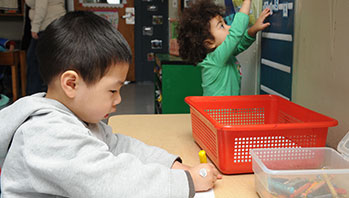- construction paper
- crayons and markers
- Owl Babies (book)
- stapler
- brave
- feeling
MA Standards:
Literature/RL.PK.MA.2: With prompting and support, retell a sequence of events from a story read aloud.
Literature/RL.PK.MA.3: With prompting and support, act out characters and events from a story or poem read aloud.
Speaking and Listening/SL.PK.MA.2: Recall information for short periods of time and retell, act out, or represent information from a text read aloud, a recording, or a video (e.g., watch a video about birds and their habitats and make drawings or constructions of birds and their nests).
Head Start Outcomes:
Literacy Knowledge/Book Appreciation and Knowledge: Retells stories or information from books through conversation, artistic works, creative movement, or drama.
PreK Learning Guidelines:
English Language Arts/Reading and Literature 10: Engage actively in read-aloud activities by asking questions, offering ideas, predicting or retelling important parts of a story or informational book.
"Our Owl Babies"

© Commonwealth of Massachusetts, Department of Early Education and Care (Jennifer Waddell photographer). All rights reserved.
Do a picture walk with children and have them discuss different events in the story. Encourage them to look at the illustrations as they describe the characters, the deep, dark woods, how the owls are feeling, etc.
Then have each child choose one part of the book they like the best. Ask, What did you like about that part of the book?
Explain to children that they are going to draw a picture of their favorite part of the book. Have them describe what they like about that scene and help them write it on the bottom of their drawing. Encourage children to "write" their name on their drawing.
When all children have completed their drawings, gather them and make a group book titled "Our Owl Babies." Have volunteers decorate the cover and display the book in the Library Center for children to revisit.
English Language Learners: Use images and facial expressions to help children understand the emotions attached to feeling words. For example, hold up a picture of someone feeling worried about something and make a worried expression on your face. Discuss how you feel when you are worried. Have children repeat with their own expression and description. Continue with other feeling words.
